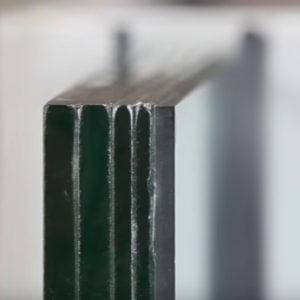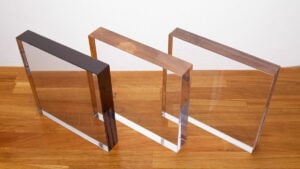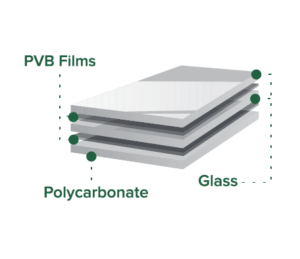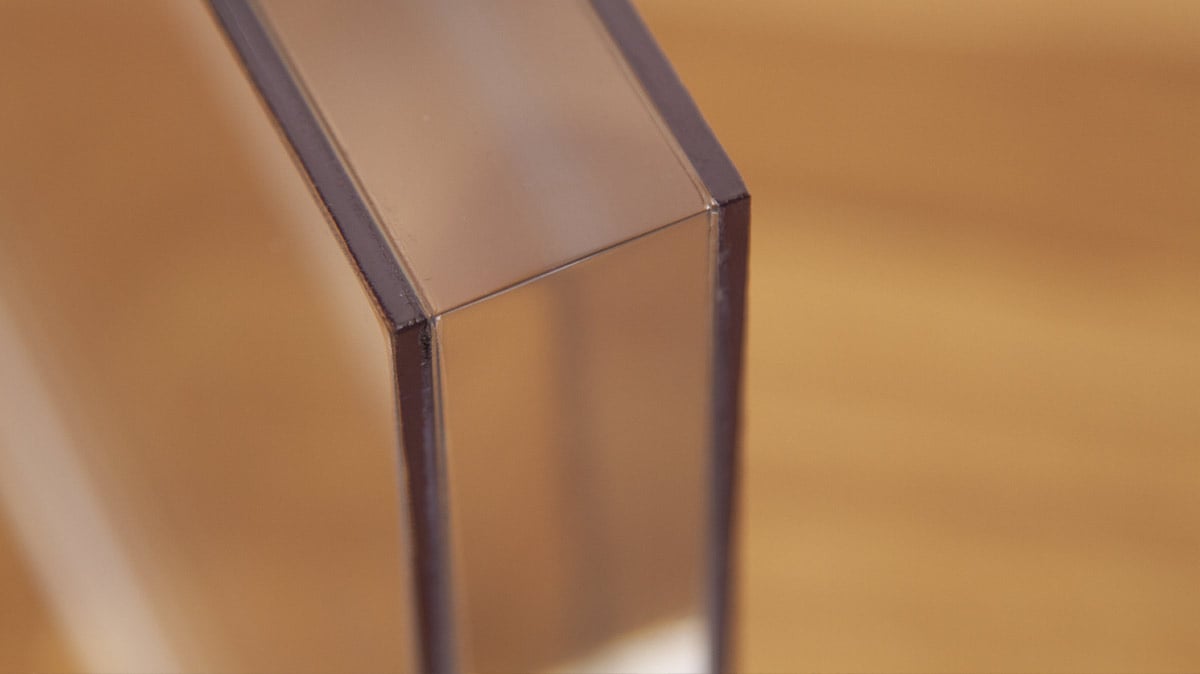Laminated glass is a term dating back over a century, but many people don’t realize how much this layered safety glass has evolved, and how modern iterations of it can be employed across a variety of practical uses.
What is Laminated Glass?
Simply put, laminated glass is stacked glass bound together with a type of resin. The types of materials used, and the fabrication processes employed have greatly evolved over the years and we’ve now seen laminated glass used in countless shapes, styles, and forms. With many different materials and products on the market, all laying claim to the “laminated glass” label, you have more options than ever when using it in your next build. Despite the increased options, though, true laminated glass products still generally follow the same principles of manufacturing and design.
When used in bulletproof security installations, laminated glass has historically been a key component in windows or other clear barriers. However, it’s important to note how this type of glass has evolved and why/when it’s best used as part of an overall design – ballistic or otherwise.

A Brief History of Laminated Glass
Laminated glass was invented by accident. In 1903 French chemist Edouard Benedictus fumbled a beaker he had been using to produce a batch of simple plastic. The glass beaker broke but did not shatter, because the plastic material inside held the shards in place. Benedictus immediately saw the potential: glass that didn’t easily shatter posed a much lower safety risk.
His discovery first saw widespread use in the eyepieces for World War I gas masks and aviator goggles. Soon after, it was widely adopted for car windshields. By World War II, manufacturers were laminating sheets of tempered glass into panes several inches thick. The military used these for windows in bunkers, tanks, and bombers.
This was the birth of the first ballistic windows.
Evolution of Laminated Glass into Modern Ballistic Products
Laminated windows have been around now for more than a century. Throughout that time, glass manufacturers and security companies have continually experimented with different resins, interlayers, and transparencies, which has led to vast improvements and increased usage in a wider array of applications – including different uses in ballistic design.
The results speak for themselves – high-performance laminated windows can:
- Stop bullets
- Prevent break-ins
- Increase privacy
- Improve energy efficiency
- Even selectively let bullets through.
Sidebar: “Why would you want to let bullets through? Consider the benefit of high-tech ballistic glass that catches/stops incoming bullets while allowing outgoing bullets to pass through. High-performance windows can be manufactured to do just that.
In recent decades, advancements in thermoplastics (especially acrylic and polycarbonate) have greatly expanded what we can accomplish with laminated windows from both a design and safety standpoint. Every layer in a laminated window is an opportunity to further enhance the material’s performance. Do you want to make the window frosted? Mirrored? Tinted? Low-E for greater energy efficiency? Do you want to add a forced-entry or blast-rating? Stop a larger caliber bullet with a thinner piece of transparency? All these options—and more—are on the table.
Best Practices for Using Laminated Windows in your Bulletproof Security Installation
With the expansion of laminated glass options into different mixed-material makeups, it’s more important than ever to understand why and when to use which types of laminated glass.
For starters, most high-performance laminated “glass” isn’t glass at all – or at least it’s not entirely made of glass. Different blends of acrylics, polycarbonates, and other clear materials are blended to varying degrees with actual glass – or, in some cases, without any glass at all.
Key takeaway: these evolved versions of laminated “glass” products have come a long way; don’t be immediately swayed by companies advertising all-glass laminated windows – you might find that a product without any actual glass at all does a better job serving your needs.
Consider Your Best Options – Including the Best Materials
 There are companies today that advertise all-glass laminated windows for stopping a bullet from a .50 caliber sniper rifle. That sounds great. But does that make it the best option for your space? Set aside whether you need a Level 10 window for your business or city office and instead consider if you want to use an all-glass laminated window. It’s four inches thick and weighs 50 pounds per square foot.
There are companies today that advertise all-glass laminated windows for stopping a bullet from a .50 caliber sniper rifle. That sounds great. But does that make it the best option for your space? Set aside whether you need a Level 10 window for your business or city office and instead consider if you want to use an all-glass laminated window. It’s four inches thick and weighs 50 pounds per square foot.
“There are a few applications where all-glass laminated windows are still a good choice,” explains Bob George, a senior consultant with Total Security Solutions. “But in all honesty, all-glass laminates are kind of a dinosaur in the industry. In almost every case, you’ll be better served by a laminated window that combines plastics with glass—or even one that has no glass in it at all.”
At first glance, an all-glass laminated window seems like the most affordable option. And, simply in terms of raw materials, that may be the case. This is an older style of ballistic transparency. It uses older (less expensive) technology and relies on common materials. The real cost lies in the fabrication process.
Most modern bullet-resistant barrier systems need more than a simple slab of glass that can stop a bullet. They need an integrated barrier system. That means fabricating materials—cutting and forming them to smoothly mesh into a seamless barrier. The details required to properly pull it all together end up costing more than people realize. That fabrication process costs more, but it’s well-worth it. The quality in both the safety provided and the overall look & design is far superior to products produced from older methods.
Learn more about the 8 Levels of Bulletproof Resistance
Fabrication Issues with All-Glass Laminated Windows
“Typically, on an interior barrier system, we try to stay away from glass [laminates],” explains Bob George. “Because it limits what you can do. When you include glass in the makeup of a laminated window, the manufacturing and fabrication become more labor-intensive and take more time.”
Edge polishing is a perfect example, according to George. If the edge of the glass is going to be at all exposed, it needs to be properly finished.
“To polish the edge on a laminated window that includes any glass layers, that’s a tedious process that uses specialized equipment. It eats up a lot of work hours to get it done. If you made the same size laminated window with the same security rating, but the makeup was entirely acrylic and polycarbonate layers, that’s totally different. We can flame polish those edges, and it’s a very straightforward process. In some cases, it can be just a few minutes of work. It looks great, and is much less labor-intensive.”
These increased fabrication costs aren’t limited to cosmetic details. Any fabrication of a glass laminated window—from cutting talk holes and backers to creating arched windows, or even simply drilling the material for mounting fasteners—is labor-intensive. Those costs add up quickly unless you shift the entire design to minimize cuts and fabrication. However, doing that will almost invariably translate into a less attractive barrier more likely to impede flow and communication.
With Modern Processes Comes Modern Design
Think about the evolution of clear barriers – and even floors and ceilings! – in modern design applications.
The use of glass has transformed the realm of possibilities in the architecture industry. Glass provides transparency, allowing for unobstructed views of the outside environment and plenty of natural light. Once a luxury to only the wealthy, glass has now become widely used in both exterior and interior architectural applications, including the famous all-glass stair treads of the Fifth Avenue Apple Store. Other over-the-top architectural glass installations include China’s new glass-bottom bridge and the giant glass high heel church built in Taiwan.
There have, unfortunately, also been alarming accidents from using the wrong types of glass materials and products in certain examples of modern design that sacrificed safety for savings. In response to multiple incidents in the early years of the 21st century that led to crumbling glass structures, the Glazing Industry Code Committee (GICC) implemented revisions to the existing railing section of the 2015 International Building Code, which is widely used in the United States. Handrail assemblies, guard rails or guard sections, or installations where broken glass could fall on individuals below, were required to use laminated glass (instead of tempered glass or other inferior versions) due to its recognized superior attributes in safety applications.
Secured Glass Walkways Provide Thrilling Views
One design trend gaining popularity is the all-glass walkway that started with the Grand Canyon Skywalk and has since taken hold in other popular attractions around the world. What do they have in common? High-performance laminated glass ensures the highest safety standards in otherwise precarious situations.
The Grand Canyon Skywalk hovers 4,000 feet above the floor of the Grand Canyon jutting 70 feet past the rim. The design is a u-shaped, partially enclosed cantilevered glass walk with a 2.8 inches thick floor, comprised of five layers of glass. The Skywalk was built to sustain an 8.0 earthquake and is strong enough to support about 71 fully-loaded 747 jets.

If 4,000 feet is just a bit too high for you, perhaps the Willis Tower Skydeck in Chicago is more your speed. Opened in 2009, the Skydeck offers visitors a view of the city from 1,353 feet in the air. Comprised of three half-inch thick layers of glass laminated seamlessly into one unit, the four fully enclosed glass boxes can retract into the building for cleaning and maintenance. Halcrow Yolles, experts in international structural glass design, were able to eliminate all the structural steel along the perimeter and sides to create a near-invisible support system, making visitors feel as though they are truly floating above the city.
One of the more recent structures to undergo the addition of a glass floor is the Eiffel Tower. In an effort to revitalize the city, the first floor of the Eiffel Tower was outfitted with glass, providing dramatic views to the ground 187 feet below. Made by laminating three sheets of glass with two high-strength films, the final product is about 1.25 inches thick.
While each venue takes a slightly different approach to the increasingly popular glass walkway, there is one structural similarity –- laminated glass. Because glass can be damaged and fail instantaneously, each layer of glass is actually designed to support the necessary load. So, while it might not entirely ease your mind to know that glass can fail – and quite often does – take some comfort in knowing that these glass walkways have been over-engineered to account for such shortcomings and keep you safe.
The key takeaway here is that laminated glass has continued evolving into more applications and higher safety standards. Engineers, architects, and designers can confidently rely on high-performance laminated glass products to provide a modern look with impeccable safety standards.
High-Performance Laminated Windows
While newer transparent blends, like thick sheets of acrylic or polycarbonate, have largely replaced glass in most bullet resistant systems, lamination has remained vital to bulletproof installations.
Laminating Modern Bulletproof Plastics
Although thick acrylic or polycarbonate is itself bullet resistant, laminating thinner sheets of these materials together allows manufacturers to build durable systems with known bullet resistance, or to accentuate specific characteristics by combining materials. For example, acrylic offers excellent clarity and light transmission, but can send chips flying when struck by a bullet. While polycarbonate is “low-spalling” (i.e., unlikely to cast off dangerous little shards upon impact), thicker sheets absorb a lot of light, making interiors seem dim. A skilled laminator can combine layers of acrylic and polycarbonate to retain much of acrylic’s bright aesthetic, and still protect against possible injury from flying debris.
By binding sheets together, the laminate doesn’t just allow the characteristics of several materials to come together in a single pane, but also brings added forced-entry security and decreased spalling in the case of an attack. The final barrier is truly stronger than the sum of its parts.
Of course, advances in plastics and lamination haven’t entirely chased glass out of ballistics. An all-glass bulletproof or bullet-resistant barrier is heavy and has poor light transmission–only allowing about 60 percent through–but can also offer substantial cost savings and is thus still a good value in some modern applications.
Opting for Higher-Performance and Longer Sustainability
TSS co-founder and CEO, Jim Richards, has worked with ballistic laminated windows for decades.
“When given the option,” he notes, “people don’t actually usually want all-glass laminates for ballistic applications. Typically, because of the weight and the lack of performance, it just doesn’t make sense. When you get glass that thick, optically it isn’t great – you get waviness. There are issues.”

For example, consider a common Level 3 laminated window. Level 3 ballistic barriers stop multiple shots from any handgun. Both all-glass and all-thermoplastic Level 3 laminated windows are about an inch thick.
Both have comparable light transmissions. But that all-glass laminated window is 11 pounds per square foot, while one composed of layers of polycarbonate and acrylic is just under 8 pounds per square foot. In a standard three-by-four reception window, that’s an extra 36 pounds resting on the counters. At a teller line, that’s likely to be another 70 to 100 pounds of glass in a system that you’d like to be freestanding. And without extra expense and lead time, that all-glass laminated window cannot have the holes, arches, and broad sightlines you see here.
What Type of Laminated Glass Works Best For Your Next Project?
Determining which products will best serve your next installation will depend on your overall goals. With so many options available, it’s best to explore how each will perform in the space, as well as consider the safety effectiveness and overall cost.
TSS ballistic consultants have extensive experience providing direction in security installations of all sizes, specs, and budgets. We’ll discuss different laminated glass options – whether all-glass, partial glass, or no-glass – based on the details of your next project. We’ll provide guidance and recommendations to help you determine the best overall fit for the job.
Reach out to our team for support on your next ballistic build – or visit our gallery to see some of our recent projects!


